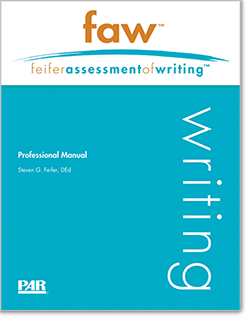
Feifer Assessment of Writing faw
Author: Steven G. Feifer, DEd
Examines the underlying processes that support written language skills
Format: Paper and pencil, Online scoring via PARiConnect, Download, E-Manual
Grade range: Preschool to College
Time: 15 minutes for Preschool; 20 minutes for K-Grade 1; 55-65 minutes for Grades 2+
Printed Forms & Handscoring Materials
Test forms, response booklets and scoring reference manuals.
Printed Manuals
Physical printed manuals.
Online Forms, Reports, Kits & e-Manuals
All online resources including Forms, Reports, i-Admins, Kits and e-Manuals.
Printed Kits
Click to browse products
FAW Examinee Response Forms (pack of 10)
FAW Examiner Record Forms (pack of 10)
FAW Stimulus Book
FAW Professional Manual
FAW Screening Form online Score Report (each) min order 5
FAW e-Manual
FAW online Score Report (each) min order 5
FAW Comprehensive Kit
Students spend nearly 60% of their school day engaged in the process of written expression. Deficits in the writing process can wreak havoc on students’ education. The FAW examines the underlying processes that support proficient written language skills. In addition to identifying the possibility of dysgraphia, the FAW is able to determine the specific subtype of dysgraphia. The Administration and Scoring Guide provides instructions that simplify assessment and make scoring straightforward.
The FAW is a diagnostic achievement test designed to examine the underlying cognitive, motoric, and linguistic processes that support proficient written language skills. It joins the FAR and the FAM as the third and final member of the Feifer Family of diagnostic achievement test batteries, all of which examine subtypes of learning disabilities using a brain–behaviour perspective.
The FAW was designed to measure three subtypes of written language disorders, or dysgraphia.
Features and benefits
Designed to measure three subtypes of written language disorders. Results help specify, from a neuropsychological perspective, exactly why a student struggles with written language so you can develop appropriate, customized interventions.
Provides qualitative information about a student’s writing skills, including a skills analysis available within most subtests that allows you to dig deeper into a student’s abilities.
Screening forms, ideal for progress monitoring, are also available.
Can be used for an array of purposes, including for general screening of dysgraphia, to direct diagnosis of a learning disability as part of a comprehensive psychological evaluation, for progress monitoring of discrete skills for school systems operating in an RTI paradigm, and to design a deficit- or skill-specific intervention.
A detailed Administration and Scoring Guide makes administration and scoring straightforward and objective. Meant to be a go-to resource during administration, the guide provides targeted advice and helpful tips.
Test structure
Three index scores are generated: the Graphomotor Index, the Dyslexic Index, and the Executive Index. The FAW Total Index represents overall test performance. Each index can be compared to each other, as well as to the total index score, to determine relative strengths and weaknesses in writing.
An optional Compositional Writing Index is available when Copy Editing and Story Mapping subtests are administered. These subtests are optional and are not included in the FAW Total Index.
Examinees in prekindergarten take five subtests, examinees in kindergarten to Grade 1 take seven subtests, and examinees in Grade 2 to college take 10 subtests.
Reliable change and discrepancy scores can be calculated.
Technical information
Subtest and index scores are scaled to the familiar IQ metric (M = 100; SD = 15).
Standardized on a sample of 1,048 participants in prekindergarten to college, drawn from 30 states and based on the 2017 U.S. Census statistics.
Includes intellectual developmental disorder, ADHD, fine motor deficits, and written language learning disability clinical samples.
Offers grade-based norms; age and grade equivalents for subtest scores; and confidence intervals, percentile ranks, z scores, and normal curve equivalents (NCEs) for index scores.



